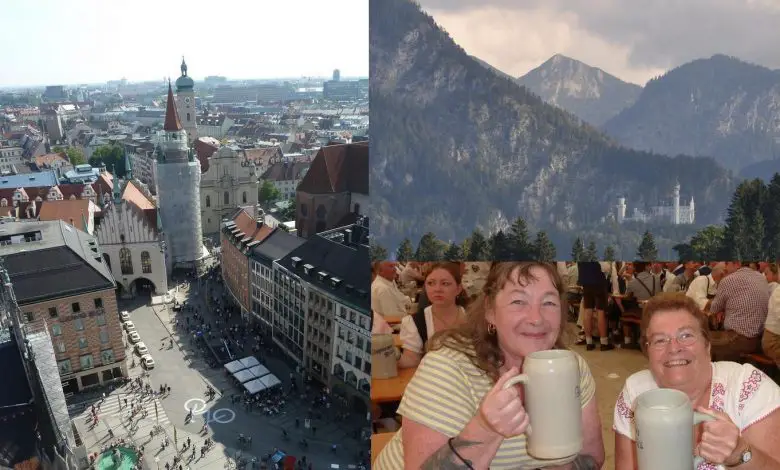
Discovering Bavaria and Makin’ Tracks: Part 1
Makin’ Tracks is an independent, family-run business offering overseas tours to wheelchair users. Here they tell Disability Horizons about their first trip to Bavaria.
Our tours are all about discovery and enabling people to connect with the country we are visiting. After three decades spent exploring Europe, on behalf of groups of wheelchair users, it would be nigh on impossible for me to take a back seat and rely on third parties to plan our excursions. I adore the driving, am fascinated by learning, excited at the prospect of sharing experiences, and love laying a tour out as an unfolding story. We, therefore, intensively research excursions prior to the groups’ arrivals, with countless possibilities discarded for every place that finally ends up on our itinerary.
In September of last year we ran two tours in Bavaria. It’s an area we’ve driven through on countless occasions over the last three decades, and it’s certainly caught my eye, but it’s taken until now to finally set up base there and acquaint ourselves with its charms.
Munich
While driving around Munich, one could easily presume that this must be one of Central Europe’s great capitals. The northern part of the centre is particularly characterful, with a ceremonial approach, historic churches, and world-class museums and art galleries. Art lovers could pass a couple of days alone in the old, new and contemporary galleries. Most of the central churches are accessible, though I never found a way to avoid Asamkirche‘s quirky steps.
Some amazing street entertainers from around the world frequent the centre, including professional musicians with international reputations. The heart of Munich is the Marienplatz, where the impressive Altes Rathaus building houses a clock that does a crowd-pulling little show at noon. Its tower also has an old lift that takes you up to the roof for an amazing view. While it clearly pre-dates accessibility standards, we made it up there with a small powered wheelchair. The most central accessible toilet is just through the archway to the right of the clock.
Notable accessible aerial views further from the centre are from the 1972 Olympic tower, and the Mercedes building. The Augustinerbräu, Munich’s oldest brewery, founded by Augustinian monks around 700 years ago, is now also an attractive and lively dining area, and fully accessible, including its toilets. I’m reluctant to trust accessibility information, but I found the barrier free tourism website to be remarkably detailed and pretty accurate, and so would recommend it as a first stop resource. They’ve even gone to the trouble of producing a map showing cobbled areas & steps.
Oktoberfest
Despite being a successful home to cutting edge industry like BMW cars, Bavarians are also deeply traditional. They look after their architectural heritage and landscape, together with their cultural traditions. Harvest decorations amazed us wherever we went.
Our tours coincided with Munich’s legendary Oktoberfest (held every September). The Oktoberfest is described as the world’s largest people’s fair. It is certainly immense, it gets wild as the evening develops and beer is of course the central ingredient, but it’s family friendly in the afternoons, especially at weekends, and is surprisingly easy to get round by wheelchair.
There is a huge special car park at the southern end of the site, tarmac pathways throughout, ramps and accessible toilets in each tent. Even the historic big wheel has two cabins with widened access for standard wheelchairs. Plus, you can queue jump for the wheel once the attention of staff has been caught.
The festival continues to exist because of the big breweries, which are supplied by the world’s largest hop-growing region just to the north. We were pleased to discover the hotel of the same name as the region, the Hotel Hallertau, in the town of Wolnzach. With something like 20 accessible rooms, some with electrically adjustable beds, we felt like Christmas had come early. We are probably unique in providing only accessible rooms with roll-in showers on our tours, while coming up with new destinations every year. Even though we keep to small groups, where we only need 4 or 5 rooms, our search for suitable accommodation usually turns into a major piece of detective work, and there are entire countries we’ve pretty much given up on!
Wolnzach
Wolnzach is quite a sweet town, with colourful old buildings, and an impressive piece of contemporary architecture dedicated to the story of hops, the German Hop Museum. This building is fully accessible, has static displays with audio guides in English, and extremely helpful staff. I wouldn’t go out of my way for a visit, but if you happen to be in the town anyway, and you’re curious about hops, you might as well. Our parties were quite polarised in their views; people with a connection to the land in their families loved it, arty intellectuals dismissed the whole thing.
The scenery of Bavaria varies from pretty – with rolling wooded hills and picturesque villages in the Hallertau – to absolutely breathtaking – with Alpine peaks and fairytale castles on the Austrian border. With our own vehicle, we were able to explore it to the full.
To book a holiday with Makin’ Tracks visit their website.
By Dave Jepson of Makin’ Tracks
Check back next week for the second installment of this travel guide for more useful tips. Make sure you don’t miss it by following us on Twitter and joining us on Facebook.
If you’re feeling inspired to go on holiday yourself, why not check out our Travel section? We have a variety of stories spanning the globe from South Africa to New York, Thailand to Ecuador.